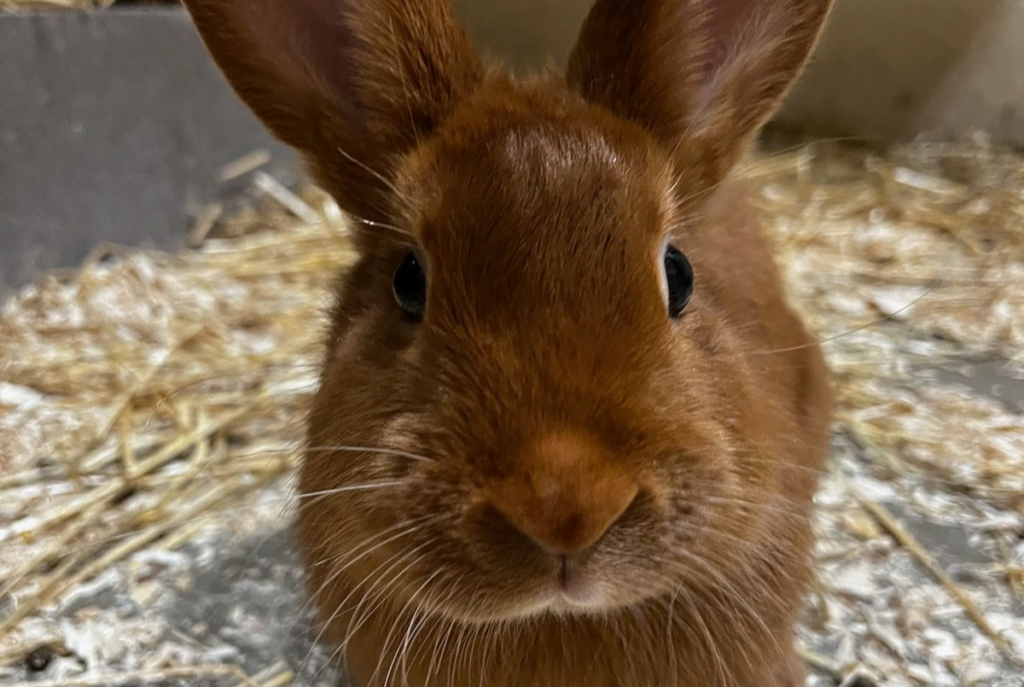Domestic Rabbit

Basic Information:
Scientific Name: Oryctolagus cuniculus
Habitat: While the original rabbit came from mainland Europe, they were domesticated around 1,500 years ago. Today, domesticated rabbits can be found all around the world!
Diet: Rabbits eat a combination of hay, alfalfa, grass, plants, vegetables, and – being domesticated – specialty rabbit food.
Size: 0.8 feet to 2 feet
Weight: 2 to 16 pounds
Lifespan: 8 to 12 years
Distribution Map:
I.U.C.N Conservation Status:

What does this mean?
Least Concern – a species determined by the International Union for Conservation of Nature (I.U.C.N.) to be pervasive, abundant, and thriving.
Our Rabbits:
Brioche (Male) – Born July 14, 2023 (*Dutch Rabbit*)
Ciabatta (Male) – Born July 14, 2023 (*Dutch Rabbit*)
Squibbert (Male) – Born June 3, 2023 (*Thrianta Rabbit*)
Shenanigan (Female) – Born July 18, 2023 (*Thrianta Rabbit*)
About Dutch Rabbits:
Despite their name, Dutch rabbits aren’t originally from the Netherlands! In fact, the Dutch rabbit is actually an English breed that is descended from a separate breed imported from Belgium in the 1830s for meat markets. Of course, many people took them in as pets and – through selective breeding – created the Dutch rabbit. These bunnies are distinguishable by their unique color pattern: white nose, white collar, and white upper portion of the body (or “saddle”). Outside of this distinct pattern, these rabbits can be one of 7 different colors: black, blue, chinchilla, chocolate, gray, steel, and tortoise. This breed is also known for being small, friendly, and intelligent. Today, they are one of the top breeds for pet rabbits in the world!
About Thrianta Rabbits:
Thrianta rabbits are a very new breed. In the 1930s, a Dutch schoolteacher – H. Andreae – decided to show his loyalty to the royal family – the House of Orange-Nassau – by breeding an orange colored rabbit to match the color of the Dutch royal colors. Unfortunately, many were lost in World War 2 due to the Dutch people using them for meat when food rations became scarce. Thankfully, the surviving population ended up recovering through breeding with German Sachsengold rabbits. However, due to the cross-breeding, Thriantas weren’t officially recognized as a separate breed until the 1980s. While they are still relatively rare, they are slowly growing in popularity. Today, the American Rabbit Breeders Association (ARBA) recognize Thriantas as a “fancy” breed, and they are known for being very easygoing and friendly.
Did You Know?!
- A rabbit’s teeth continuously grow! This is the reason that they are so prone to chew on things: they need to file down their teeth before they get too long. This is one reason why it is important to give pet rabbits plenty to chew on because otherwise they will opt to file their teeth on your furniture!
- Happy rabbits are known to do what is called “binkying.” This special jump is typically higher than normal and involves twists and flips. If you see a rabbit doing this, it is a good sign!
- The common phrase “breeding like rabbits” has to do with a rabbit’s VERY short gestation period. Depending on the breed, a mother can give birth about 1 month after getting pregnant. One litter can result in up to 14 babies! After this, the mother is capable of getting pregnant again about 1 day later. So unchecked rabbits are capable of exploding in population size VERY quickly. For example, there are estimated to be about 200,000,000 feral rabbits in Australia! As of 2021, there were less than 26,000,000 people living on the same continent!
- A male rabbit is called a buck, a female rabbit is called a doe, a baby rabbit is called a kit, and a group of rabbits is called colony or a fluffle!
- A fluffle of rabbits live in underground burrows known as warrens. These warrens can feature multiple “rooms” connected by tunnels. Large warrens can reach up to a size of more than 2 acres!
- Rabbits are known to make a “purring” sound when they are content. However, while a cat purrs using their through, a rabbit purrs by grinding their teeth on each other.
- Being a prey animal, rabbits have multiple ways to help keep them safe. Their large ears are capable of rotating 270 degrees and hearing sounds almost 2 miles away. Additionally, the eyes on the side of their heads give them the ability to see up to 360 degrees around them. Both of these features – their ears and eyes – allow them to get a good grasp of their surroundings to avoid potential predators.
- Rabbits are what are known as lagomorphs. While they are similar to rodents in that their teeth continuously grow, lagomorphs differ in a few ways. First, they are always vegetarian while rodents can occasionally eat insects and/or meat. Second, lagomorphs do not have paw pads and – instead – have fur that covers their entire feet!
